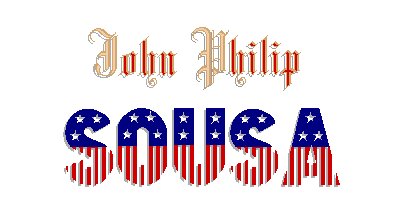



But there are so many more that we know when we hear them, yet most people don't realize that these pieces, too, are Sousa's. For instance, many people instantly recognize the song being played by the band in the parade secne from the original production of Miracle on 34th Street - but how many realize that the song is Sabre and Spurs, written by Sousa in 1918 and dedicated to the officers and men of the 311th Cavalry? Another example is the theme from the Monty Python television series; in reality, that piece was written by Sousa in 1893 and is actually called the Liberty Bell march.
Click on some of the titles below; you may not recognize the names, but if you listen to the piece through the trio (that's the classical music version of the pop-music hook), you'll probably be surprised to find that you do know at least part of it.
John Philip Sousa was born November 6, 1854, in Washington D.C. His father, John Antonio, was a trombonist in the United States Marine Band, so one might say that Sousa was born with a brass spoon in his mouth. It was at the early age of six, in fact, that John Philip Sousa first put his lips to a brass instrument, studying cornet, trombone, baritone, and alto horn; he also studied violin, flute, piano and voice.
Though well-known as the leader of the Marine Band in Washington, Sousa didn't attain that lofty position until 1880. His first experience with the Marine Band came in 1867 when, at age 13, he was enlisted, by his father, in the Marines as apprentice musician. Eight years later, at age 21, Sousa was discharged from the Marines and went to New York where he directed Gilbert and Sullivan's H.M.S. Pinafore on Broadway.
As stated earlier, Sousa became leader of the Marine Band in 1880. He held the position for 12 years, serving under five Presidents of the United States. In 1892 he was persuaded to leave the Marines and oragnize the immortal Sousa's Band.
In 1917, during World War I, Sousa enlisted in the United States Naval Reserve; age 62, he was appointed to the rank of Lieutenant and paid a symbolic salary of $1.00 per month. His enlistment was not merely a patriotic gesture; Sousa actually enlisted to train Navy bandsmen at Great Lakes Naval Training Station north of Chicago.
In 1920, at the behest of Midshipman W.A. Ingram, President of the Class of 1920 at the United States Naval Academy, Sousa wrote Who's Who in Navy Blue as the class march, dedicating it to Tecumseh (it was customary for each class to have a new march played at its gradutation - a custom which also gave birth to Anchors Aweigh).
John Philip Sousa passed away in Reading, Pennsylvania, on March 6, 1932 following a rehearsal with the Ringgold Band; the last piece Sousa conducted was The Stars and Srtipes Forever.
Sousa is known as "The March King" because his marches were such an integral part of American life in his day; he wrote marches for all manner of occasion. One example is the King Cotton march, which was written in 1895 for the Cotton States and International Exposition in Atlanta. Another example is the well-known Washington Post march: this piece was not written in honor of the Marine barracks (the Marine "post", as it were) in Washington as one might imply from its title (and realizing Sousa's strong ties to that place); it was written instead for the newspaper The Washington Post to promote an essay contest sponsored by that newspaper!
All in all Sousa composed 135 marches, 70 songs, 15 operettas, 11 suites, and 2 descriptive pieces.

Sousaphiles have dropped by since March 25, 1998
Links
The United States Marine Band - The President's Own
John Philip Sousa, American Composer, Conductor and Patriot
Brother John Philip Sousa, Salesman of Americanism
Credits
City of Orange Symphonic Band
City of Orange Symphonic Band
Notes on Sousa
 Back to Navpooh's Home Port
Back to Navpooh's Home Port